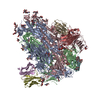[English] 日本語
 Yorodumi
Yorodumi- PDB-8xi6: SARS-CoV-2 Omicron BQ.1.1 Variant Spike Protein Complexed with MO... -
+ Open data
Open data
- Basic information
Basic information
| Entry | Database: PDB / ID: 8xi6 | ||||||
|---|---|---|---|---|---|---|---|
| Title | SARS-CoV-2 Omicron BQ.1.1 Variant Spike Protein Complexed with MO11 Fab | ||||||
 Components Components |
| ||||||
 Keywords Keywords | VIRAL PROTEIN/IMMUNE SYSTEM / SARS-CoV-2 / antibody complex / VIRAL PROTEIN / VIRAL PROTEIN-IMMUNE SYSTEM complex | ||||||
| Function / homology |  Function and homology information Function and homology informationMaturation of spike protein / viral translation / Translation of Structural Proteins / Virion Assembly and Release / host cell surface / host extracellular space / symbiont-mediated-mediated suppression of host tetherin activity / Induction of Cell-Cell Fusion / structural constituent of virion / entry receptor-mediated virion attachment to host cell ...Maturation of spike protein / viral translation / Translation of Structural Proteins / Virion Assembly and Release / host cell surface / host extracellular space / symbiont-mediated-mediated suppression of host tetherin activity / Induction of Cell-Cell Fusion / structural constituent of virion / entry receptor-mediated virion attachment to host cell / membrane fusion / Attachment and Entry / host cell endoplasmic reticulum-Golgi intermediate compartment membrane / positive regulation of viral entry into host cell / receptor-mediated virion attachment to host cell / host cell surface receptor binding / symbiont-mediated suppression of host innate immune response / receptor ligand activity / endocytosis involved in viral entry into host cell / fusion of virus membrane with host plasma membrane / fusion of virus membrane with host endosome membrane / viral envelope / virion attachment to host cell / SARS-CoV-2 activates/modulates innate and adaptive immune responses / host cell plasma membrane / virion membrane / identical protein binding / membrane / plasma membrane Similarity search - Function | ||||||
| Biological species |   Homo sapiens (human) Homo sapiens (human) | ||||||
| Method | ELECTRON MICROSCOPY / single particle reconstruction / cryo EM / Resolution: 2.3 Å | ||||||
 Authors Authors | Ishimaru, H. / Nishimura, M. / Shigematsu, H. / Marini, M.I. / Hasegawa, N. / Takamiya, R. / Iwata, S. / Mori, Y. | ||||||
| Funding support | 1items
| ||||||
 Citation Citation |  Journal: J Virol / Year: 2024 Journal: J Virol / Year: 2024Title: Epitopes of an antibody that neutralizes a wide range of SARS-CoV-2 variants in a conserved subdomain 1 of the spike protein. Authors: Hanako Ishimaru / Mitsuhiro Nishimura / Hideki Shigematsu / Maria Istiqomah Marini / Natsumi Hasegawa / Rei Takamiya / Sachiyo Iwata / Yasuko Mori /  Abstract: The evolution of severe acute respiratory syndrome coronavirus 2 (SARS-CoV-2) has continued, enabling the virus to escape from host immunity by changing its spike antigen, while biased toward the ...The evolution of severe acute respiratory syndrome coronavirus 2 (SARS-CoV-2) has continued, enabling the virus to escape from host immunity by changing its spike antigen, while biased toward the receptor-binding domain and N-terminal domain. Here, we isolated a novel pan-SARS-CoV-2 neutralizing antibody (which we named MO11) for even the recent dominators XBB.1.16 and EG.5.1, from a convalescent patient who had received three doses of an original mRNA COVID-19 vaccination. A cryo-electron microscopy analysis of the spike-MO11 complex at 2.3 Å atomic resolution revealed that it recognizes a conserved epitope hidden behind a glycan shield at N331 on subdomain 1 (SD1), holding both the N- and C-terminal segments comprising SD1. Our identification of MO11 unveiled the functional importance of SD1 for the spike's function, and we discuss the potential availability of a novel common epitope among the SARS-CoV-2 variants.IMPORTANCENovel severe acute respiratory syndrome coronavirus 2 variants with immune evasion ability are still repeatedly emerging, nonetheless, a part of immunity developed in responding to the antigen of earlier variants retains efficacy against recent variants irrespective of the numerous mutations. In exploration for the broadly effective antibodies, we identified a cross-neutralizing antibody, named MO11, from the B cells of the convalescent patient. MO11 targets a novel epitope in subdomain 1 (SD1) and was effective against all emerging variants including XBB.1.16 and EG.5.1. The neutralizing activity covering from D614G to EG.5.1 variants was explained by the conservation of the epitope, and it revealed the importance of the subdomain on regulating the function of the antigen for viral infection. Demonstrated identification of the neutralizing antibody that recognizes a conserved epitope implies basal contribution of such group of antibodies for prophylaxis against COVID-19. | ||||||
| History |
|
- Structure visualization
Structure visualization
| Structure viewer | Molecule:  Molmil Molmil Jmol/JSmol Jmol/JSmol |
|---|
- Downloads & links
Downloads & links
- Download
Download
| PDBx/mmCIF format |  8xi6.cif.gz 8xi6.cif.gz | 923.9 KB | Display |  PDBx/mmCIF format PDBx/mmCIF format |
|---|---|---|---|---|
| PDB format |  pdb8xi6.ent.gz pdb8xi6.ent.gz | 596.9 KB | Display |  PDB format PDB format |
| PDBx/mmJSON format |  8xi6.json.gz 8xi6.json.gz | Tree view |  PDBx/mmJSON format PDBx/mmJSON format | |
| Others |  Other downloads Other downloads |
-Validation report
| Summary document |  8xi6_validation.pdf.gz 8xi6_validation.pdf.gz | 2.2 MB | Display |  wwPDB validaton report wwPDB validaton report |
|---|---|---|---|---|
| Full document |  8xi6_full_validation.pdf.gz 8xi6_full_validation.pdf.gz | 2.2 MB | Display | |
| Data in XML |  8xi6_validation.xml.gz 8xi6_validation.xml.gz | 108.6 KB | Display | |
| Data in CIF |  8xi6_validation.cif.gz 8xi6_validation.cif.gz | 163.4 KB | Display | |
| Arichive directory |  https://data.pdbj.org/pub/pdb/validation_reports/xi/8xi6 https://data.pdbj.org/pub/pdb/validation_reports/xi/8xi6 ftp://data.pdbj.org/pub/pdb/validation_reports/xi/8xi6 ftp://data.pdbj.org/pub/pdb/validation_reports/xi/8xi6 | HTTPS FTP |
-Related structure data
| Related structure data |  38372MC M: map data used to model this data C: citing same article ( |
|---|---|
| Similar structure data | Similarity search - Function & homology  F&H Search F&H Search |
- Links
Links
- Assembly
Assembly
| Deposited unit | 
| |||||||||||||||||||||||||||||||||||||||||||||||||||||||||||||||||||||||||||||||||||||||||||||||||||||||||||||||||||||||||||||||||||||||||||||
|---|---|---|---|---|---|---|---|---|---|---|---|---|---|---|---|---|---|---|---|---|---|---|---|---|---|---|---|---|---|---|---|---|---|---|---|---|---|---|---|---|---|---|---|---|---|---|---|---|---|---|---|---|---|---|---|---|---|---|---|---|---|---|---|---|---|---|---|---|---|---|---|---|---|---|---|---|---|---|---|---|---|---|---|---|---|---|---|---|---|---|---|---|---|---|---|---|---|---|---|---|---|---|---|---|---|---|---|---|---|---|---|---|---|---|---|---|---|---|---|---|---|---|---|---|---|---|---|---|---|---|---|---|---|---|---|---|---|---|---|---|---|---|
| 1 |
| |||||||||||||||||||||||||||||||||||||||||||||||||||||||||||||||||||||||||||||||||||||||||||||||||||||||||||||||||||||||||||||||||||||||||||||
| Noncrystallographic symmetry (NCS) | NCS domain:
NCS domain segments:
|
 Movie
Movie Controller
Controller


 PDBj
PDBj




 gel filtration
gel filtration